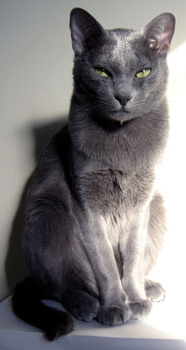|
The Scratching Post
Korat 
The Korat (also known as the Si-Sawat cat) is a medium-sized cat that is rare even in Thailand, its country of origin. The head is heart-shaped with breadth between and across the eyes. The nose has a lion-like downward curve. The chin and jaws are strong and well-developed. The ears are large with rounded tips and a large base. It has a broad chest with good spacing between the forelegs. The back is carried in a curve. The paws are oval-shaped. The tail is medium in length, thick at the base and tapers to a rounded tip. Korats are silver-blue, no matter what. If their coat is any other color, they are NOT Korats. The large and luminous eyes are wide open and over-sized. Kitten eyes are blue and change to amber with a green tinge around adolescence. The luminous green eyes occur when the cat is between two and four years old.
|
|
Temperament
|
The Korat is one of the most intelligent felines. Because of their great intellect, they have a strong will of their own and have no qualms about displaying their feelings. They have been known to be temperamental and willful. On the other hand, the Korat can also be sweet, loving and very affectionate. This ?Velcro cat? will attach themselves to their owner?s lap. They are dominant cats and will not let other cats keep them from their rightful places next to their owner. They are also very playful creatures, but caution should be shown to those who try to take away their toys when they are not ready to give them up. This breed has very acute senses of hearing, sight and scent. Because they are sensitive to noise, they do not like sudden, loud, or harsh grating sounds. Train your cat from birth to accept these sounds if you plan to show your cat.
|
|
Weight
|
8-10 lbs.
|
|
Health Problems
|
The Korat is a strong and healthy breed. It is a natural breed and not influenced by problems caused by too much selection. Regular vet checks are a must for all cats and vaccination protocol is essential.
|
|
Living Conditions
|
Keeping your cat indoors and neutering or spaying are essential elements for maintaining a healthy companion, and most importantly will extend the life expectancy of your cat.
|
|
Exercise
|
This active cat is social, playful, and full of life, but not bouncing-off-the-walls hyper.
|
|
Life Expectancy
|
15 or more years
|
|
Grooming
|
The Korat?s coat requires little grooming. However, grooming your cat about once a week benefits its health by reducing hairballs as well as cutting down on the hair they shed on clothing and furniture. The hair does not float off when they are being stroked and petted. They are good for allergy sufferers.
|
|
Origin
|
The first American cattery to breed Korats was Cedar Glen, owned and operated by Jean L. Johnson. In 1959, Jean received two imported Korats, Nara and Darra, from a friend in Bangkok. These two cats were the first known Korats to have been imported for breeding purposes. Korats began attracting the attention of cat fanciers in the 1960s and Korats were accepted for competition in CFA in the championship category in 1966.
|